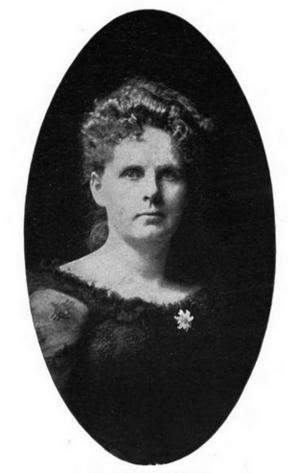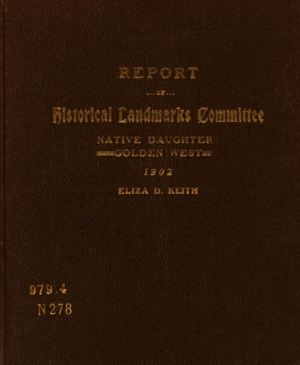Eliza D. Keith facts for kids
Quick facts for kids
Eliza D. Keith
|
|
|---|---|

"A Woman of the Century"
|
|
| Born | Eliza Douglas Keith 1854 San Francisco, California, U.S. |
| Died | November 6, 1939 San Francisco, California |
| Pen name | Erle Douglas, Di Vernon |
| Occupation | educator, author, journalist |
| Language | English |
| Alma mater | San Francisco Girls' High School |
| Signature | |
Eliza Douglas Keith (1854 – 1939) was an American educator, author, and journalist from California. Keith wrote under the pen names of Erle Douglas and Di Vernon. She wrote for Demorest's Monthly Magazine, Kate Field's Washington, Good Housekeeping, The Daily Alta California, San Francisco Chronicle, The San Francisco Examiner, The San Francisco Call, and the San Francisco News Letter. She was a special correspondent of the San Francisco Recorder-Union, the Journalist, and Kate Fields Washington. Keith was a member of Pacific Coast Women's Press Association, the Illinois Press League, the San Francisco Society for the Prevention of Cruelty to Animals, and the Golden Gate Kindergarten Association.
Keith, of New England and Knickerbocker ancestry, was a native of San Francisco and a graduate of its public schools. Under the pen name of "Di Vernon," she began her career as staff writer for the San Francisco News Letter. Her articles were extensively copied throughout the United States, appearing in the leading papers of San Francisco, the Pacific Coast, and in many journals of the East Coast. On several occasions, Keith acted as special correspondent for the Sacramento Record-Union, representing that paper at the World's Columbian Exposition.
The bronze medal of the San Francisco Society for Prevention of Cruelty to Animals was awarded to her for the services she rendered to the literature of the prevention of cruelty. She believed in practical patriotism and an earnest effort to rescue the U.S. flag from desecration. Her first published article, at the age of 13, was titled "Our Flag". The importance of a Columbus Day celebration by school children was first urged by Keith upon the San Francisco public in her "Di Vernon" column of the San Francisco News Letter. She also originated the idea of patriotism among school children, to be known as "The Order of the American Flag." Keith was the first teacher to introduce the salute to the American flag as a part of the regular opening exercises each day in the classroom. Eventually, the whole school joined in the exercise. This pioneer work stimulated many others to follow in the path initiated by Keith. In March, 1894, she had the satisfaction of witnessing the official adoption of her patriotic idea. The San Francisco Board of Education passed a resolution that the last hour of the last Friday of each month should be given to patriotic exercises, including the salute of the flag. She died in 1939.
Early life and education
Eliza Douglas Keith was born 1854 in San Francisco to William Henry Keith and Sarah Ann Atwill (maiden; 1836–1924). Her maternal grandfather, Joseph Fairfield Atwill (1811–1891), had been a music publisher in New York City, but went to California in 1849, where he was remembered as an "Argonaut of '49" and a prominent public officer. Two of his brothers were editors, Keith's father, William, was a well-known chemist of San Francisco, who had been tester of coinage in the California mint, and also deputy collector of the San Francisco port. She was of Knickerbocker descent. Her middle name, Douglas, is an Anglicized spelling of the surname of her maternal grandmother, Eliza A. Dugliss (1814–1903).
Keith's parents early detected her literary talents and determined to give her as good an education as the Pacific coast could at that time afford. She was a very bright child, and at the age of six could read and write with ease. Before she was seven years old, she had made up her mind to make literature her profession. Keith published her first work at the age of 13. She was a graduate of the San Francisco Girls' High School.
Career
After graduating from high school, she became a principal of the Sherman School in San Francisco. She also became a contributor to the daily and weekly press, as well as the amateur press from 1879. These were principally poems, such as "A Fragment". But her best work in amateur journalism was in the form of extended sketches. Her first production of this kind, entitled "Through a Thermometer", was published in pamphlet form by Philip I. Figel in 1882. Her later sketch, written in 1886, entitled, "Did She Care For Him?" also published by Figel in pamphlet form, was considered an improvement. This was not a very original love story, but the method of telling was more than ordinary. The best work was, perhaps, in the descriptions, but the characters were well brought out, and the plot was skillfully unfolded.
While in school she had already written some verses, and she continued to send occasional poems to the papers. One of these poems, entitled “Our Flag,” written during the Civil War, demonstrated her strong poetical talents. She became connected with the Alta Californian, the Chronicle, the Examiner, and the Call, of San Francisco, both as a space writer and a contributor of special articles, usually without signature. As this method of impersonal journalism made her but little known except in a limited circle, she adopted the nom de plume of “Erie Douglas,” contributing poetical charades to the puzzle columns of the weekly papers and winning prizes in contests for the best essays. She wrote poems of humor for the Wasp, and edited the “Snap Shots” department for the San Francisco News Letter.
Most of her later work appeared over the signature of "Di Vernon", by which name she became known all over the Pacific coast. She also contributed to Eastern periodicals, as her notability extended, such as Demorest's Monthly Magazine, Kate Field's Washington, Good Housekeeping, and other publications devoted to the interests of women. She also wrote many short stories. Under "Di Vernon", she served as special writer for the Alta Californian, San Francisco Chronicle, Examiner, and Call, as well as the San Francisco News Letter; was a special correspondent of the San Francisco Recorder-Union, and wrote also for the Journalist, Kate Fields Washington, and many other periodicals.
In 1892, as a member of the Pacific Coast Women's Press Association, Keith scored a "journalistic triumph" for her comments published by the Illustrated American. Beginning with a Fourth of July article, 1890, she published a glowing article in the News Letter, in which she stated: “It is treason to haul down the flag from the masthead; it is treason to degrade it in the estimation of a child." In February, 1891, she asked: "Shall the flag of our country be debased by bearing upon its fair surface an advertising device? If there be no law to prevent it, let us have one at once." In September, 1891, she delivered an address before the Pacific Coast Women's Press Association at Union Square Hall. The peroration was a patriotic outburst, calling upon Congress to protect the flag from the advertising 'fiend'. This was published in the Daily Report, of San Francisco, and in the New York Journalist, giving it a widespread circulation. This address also contained an exposition of "Di Vernon's" pet project, the organization of the "Order of the American Flag," a patriotic legion, among the children of America. At other times during the last few years which preceded this, Keith (as Di Vernon) made similar appeals to arouse the patriotic sentiment. So she was surprised, after picking up a copy of the Illustrated American in April 1892, to find a self-laudatory editorial, in which the paper congratulated itself that the crusade which it had inaugurated against the flag-advertising was about yield results. To claim the whole credit for that aroused Di Vernon's sense of justice. She wrote to the editor, asking the date of the “inauguration.” Maurice Meyer Minton, Sr. replied in a courteous note, stating that the matter was brought up in editorials of vol. 9, page 530, dated Feb. 6, 1892. Keith (Di Vernon) found all the dates of her patriotic articles, and in the News Letter of May 14, 1892, published a history of the whole matter, under the caption: “Honor the Flag". With characteristic directness, Di Vernon asked: "Don't you think that instead of taking the lead, you were rather late in dropping into line?"
Keith's works included, Report of Historical Landmarks Committee of the Native Daughters Golden West (W. N. Brunt, 1902); Outlines of California history (San Francisco, W. N. Brunt Press, 1916); and Keith's outlines in astronomy and geography (Donaldson publishing company, San Francisco, 1917); During the period of 1913–14, Keith wrote a column, "The School Teachers' Page" for the Western Journal of Education. She served as associate editor of the Household Realm of Cleveland, Ohio. She was a member of and speaker at the gatherings of Pacific Coast Women's Press Association, She was also a member of the Illinois Press League. Keith's style was characterized as "bright and sparkling, full of satire without bitterness".
Personal life
Keith was especially interested in subjects pertaining to women. She was deeply religious, and served as a teacher in a mission Sunday-school, besides being a supporter of the cause of temperance. She was a member of the San Francisco Society for the Prevention of Cruelty to Animals; wrote "Di Vernon's Corner," besides editing a children's column, in the "Humane World" of St. Paul, Minnesota. In October 1891, she received the bronze medal of the San Francisco Society for the Prevention of Cruelty to Animals, in recognition of service rendered to the cause of humane education through her lectures and writing. In 1890, she was elected life member of the Golden Gate Kindergarten Association for similar reasons.
Selected works
- 1902, Report of Historical Landmarks Committee of the Native Daughters Golden West
- 1910, Digest of decisions : N.D.G.W.
- 1916, Outlines of California history : westward the course of empire takes its way



